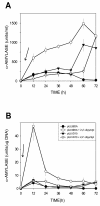Characterization of the iron-regulated desA promoter of Streptomyces pilosus as a system for controlled gene expression in actinomycetes
- PMID: 12801423
- PMCID: PMC161790
- DOI: 10.1186/1475-2859-2-5
Characterization of the iron-regulated desA promoter of Streptomyces pilosus as a system for controlled gene expression in actinomycetes
Abstract
BACKGROUND: The bioavailability of iron is quite low since it is usually present as insoluble complexes. To solve the bioavailability problem microorganisms have developed highly efficient iron-scavenging systems based on the synthesis of siderophores that have high iron affinity. The systems of iron assimilation in microorganisms are strictly regulated to control the intracellular iron levels since at high concentrations iron is toxic for cells. Streptomyces pilosus synthesizes the siderofore desferrioxamine B. The first step in desferrioxamine biosynthesis is decarboxylation of L-lysine to form cadaverine, a desferrioxamine B precursor. This reaction is catalyzed by the lysine decarboxylase, an enzyme encoded by the desA gene that is repressed by iron. RESULTS: The binding of the DmdR (acronym for divalent metal dependent repressor) to the desA promoter in presence of Fe2+ or other divalent ions has been characterized. A 51 bp DNA fragment of the desA promoter containing the 9 bp inverted repeat was sufficient for binding of the DmdR repressor, as observed by the electrophoretic mobility shift assay. The desA mobility shift was prevented by neutralizing DmdR with anti-DmdR antibodies or by chelating the divalent metal in the binding reaction with 2,2'-dipyridyl. Binding to the desA promoter was observed with purified DmdR repressors of Streptomyces coelicolor or Rhodococcus fascians suggesting that there is a common mechanism of iron-regulation in actinomycetes. The complete desA promoter region was coupled using transcriptional fusions to the amy reporter gene (encoding alpha-amylase) in low copy or multicopy Streptomyces vectors. The iron-regulated desA promoter was induced by addition of the iron chelating agent 2,2'-dipyridyl resulting in a strong expression of the reporter gene. CONCLUSIONS: The iron-regulated desA promoter can be used for inducible expression of genes in Streptomyces species, as shown by de-repression of the promoter when coupled to a reporter gene.
Figures






Similar articles
-
Transcriptional regulation of the desferrioxamine gene cluster of Streptomyces coelicolor is mediated by binding of DmdR1 to an iron box in the promoter of the desA gene.FEBS J. 2007 Feb;274(4):1110-22. doi: 10.1111/j.1742-4658.2007.05662.x. Epub 2007 Jan 25. FEBS J. 2007. PMID: 17257267
-
Iron-regulatory proteins DmdR1 and DmdR2 of Streptomyces coelicolor form two different DNA-protein complexes with iron boxes.Biochem J. 2004 Jun 1;380(Pt 2):497-503. doi: 10.1042/BJ20031945. Biochem J. 2004. PMID: 14960152 Free PMC article.
-
Functional analysis of two divalent metal-dependent regulatory genes dmdR1 and dmdR2 in Streptomyces coelicolor and proteome changes in deletion mutants.FEBS J. 2005 Feb;272(3):725-35. doi: 10.1111/j.1742-4658.2004.04509.x. FEBS J. 2005. PMID: 15670153
-
The Syringate O-Demethylase Gene of Sphingobium sp. Strain SYK-6 Is Regulated by DesX, while Other Vanillate and Syringate Catabolism Genes Are Regulated by DesR.Appl Environ Microbiol. 2020 Oct 28;86(22):e01712-20. doi: 10.1128/AEM.01712-20. Print 2020 Oct 28. Appl Environ Microbiol. 2020. PMID: 32917754 Free PMC article.
-
Iron chelator-inducible expression system for Escherichia coli.J Microbiol Biotechnol. 2008 Aug;18(8):1357-63. J Microbiol Biotechnol. 2008. PMID: 18756094
Cited by
-
Actinomycetes as host cells for production of recombinant proteins.Microb Cell Fact. 2005 Mar 23;4(1):7. doi: 10.1186/1475-2859-4-7. Microb Cell Fact. 2005. PMID: 15788099 Free PMC article.
-
A synthetic luxCDABE gene cluster optimized for expression in high-GC bacteria.Nucleic Acids Res. 2007;35(6):e46. doi: 10.1093/nar/gkm086. Epub 2007 Mar 1. Nucleic Acids Res. 2007. PMID: 17337439 Free PMC article.
-
Identification and molecular characterization of a metagenome-derived L-lysine decarboxylase gene from subtropical soil microorganisms.PLoS One. 2017 Sep 20;12(9):e0185060. doi: 10.1371/journal.pone.0185060. eCollection 2017. PLoS One. 2017. PMID: 28931053 Free PMC article.
-
Current Approaches for Genetic Manipulation of Streptomyces spp.-Key Bacteria for Biotechnology and Environment.BioTech (Basel). 2025 Jan 2;14(1):3. doi: 10.3390/biotech14010003. BioTech (Basel). 2025. PMID: 39846552 Free PMC article. Review.
-
Streptomyces Volatile Compounds Influence Exploration and Microbial Community Dynamics by Altering Iron Availability.mBio. 2019 Mar 5;10(2):e00171-19. doi: 10.1128/mBio.00171-19. mBio. 2019. PMID: 30837334 Free PMC article.
References
-
- Weinberg ED. The development of awareness of iron-withholding defense. Prospect Biol Med. 1993;36:215–221. - PubMed
-
- Neilands JB. Microbial envelope proteins related to iron. Annu Rev Microbiol. 1982;36:285–309. - PubMed
-
- Neilands JB. Siderophores: structure and function of microbial iron transport compounds. J Biol Chem. 1995;270:26723–26726. - PubMed
LinkOut - more resources
Full Text Sources

